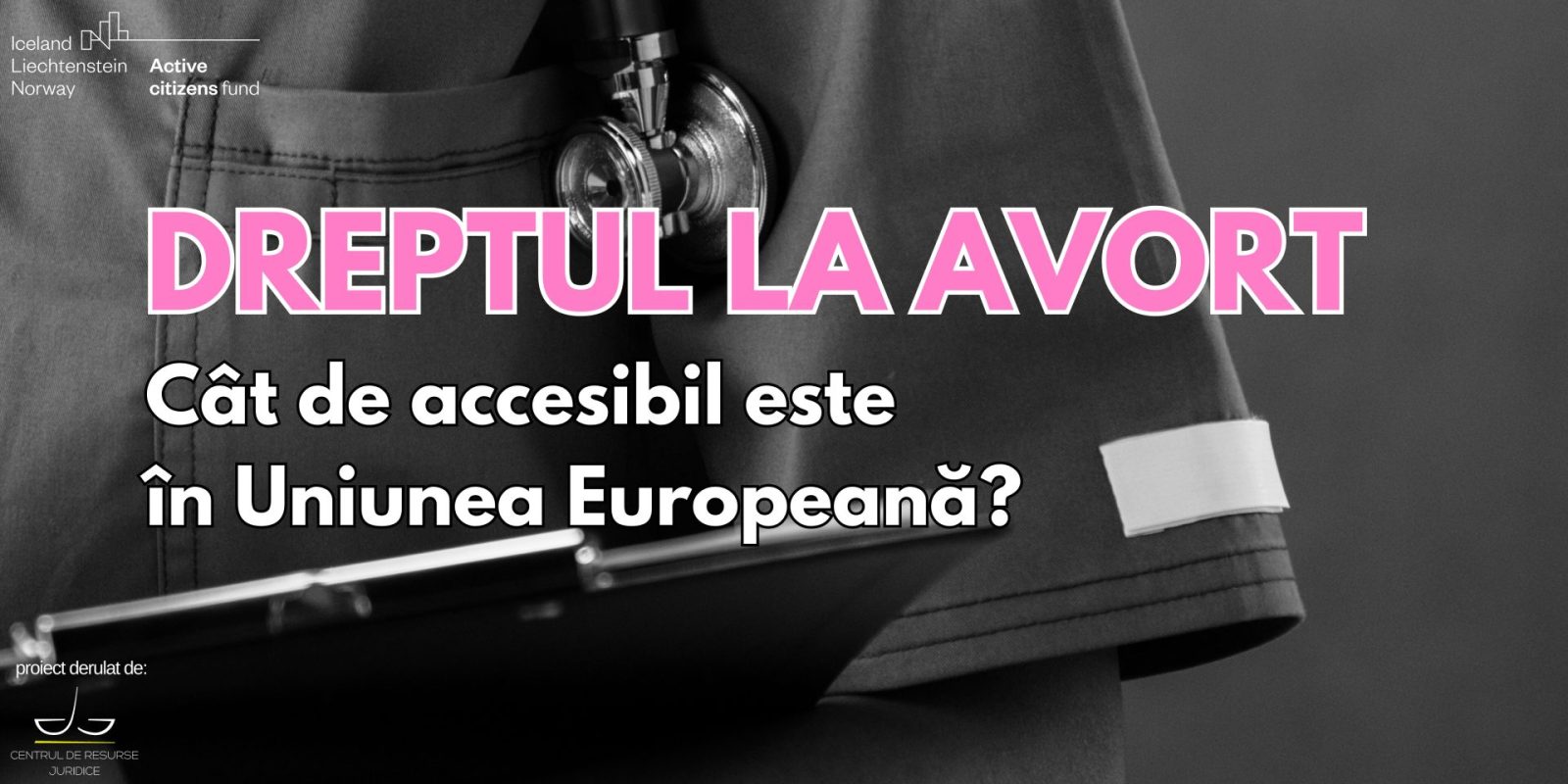- Abortion in the European present – THE FACTS
The latest reports show that in Romania in 2019, there were entire counties where state hospitals were not performing abortions on request.[1] Doctors in state hospitals cite religious, conscientious or even bureaucratic reasons for their refusal,[2] although the same reasons do not prevent them from referring their patients to their private clinics.[3] In the context of the COVID-19 pandemic, access to abortion on request became even more restrictive, to such an extent that out of 171 hospitals, only 59 offered abortion on demand.[4]
If we look at this data in isolation, it might seem that Romania is a singular and atypical case, where although the law allows abortion on demand up to 14 weeks,[5] state hospitals refuse to offer this service. However, this practice is also widespread in other European Union (EU) countries. 21 EU Member States have laws that allow a doctor’s refusal to provide abortion on religious or moral grounds, the only exceptions being Sweden, Finland, Bulgaria and the Czech Republic. [6]
In Italy in 2019, it was reported that 68.4% of gynaecologists refused to provide abortion services on religious grounds.[7] Currently, in some regions of Austria there is no doctor or only one doctor performing abortions.[8] In Slovakia, only surgical abortion is allowed, so people who want a medical abortion have to go to Austria to get the medication.[9] It is clear that, across Europe, access to abortion is getting harder every day.[10]
In 2013, the situation in Italy drew the attention of the European Committee of Social Rights, the body that monitors compliance with the European Social Charter (ESC), which issued a decision on issues such as the declining number of hospitals offering abortion services and the phenomenon of hospitals where the gynaecologists would refuse abortion requests.[11] The Committee affirmed that if the state does not ensure that legal abortions are provided[12] and forces patients to travel from one region to another to access these services, it renders irrelevant the role of the National Health Service of covering the costs because access to abortion does not exist in practice.[13] In conclusion, it ruled that this practice constitutes a violation of the right to health protection enshrined in Article 11 ESC[14] in conjunction with Article E ESC (non-discrimination).[15] Thus, according to the Committee, the right to abortion lies at the intersection of two rights: the right to health and the prohibition of discrimination.
- Abortion in the European present – THE LAW
In July 2022, in response to the US Supreme Court’s decision to overturn the precedent set by Roe v. Wade protecting the right to abortion at the constitutional level,[16] the European Parliament adopted a resolution proposing that the right to abortion be included in the Charter of Fundamental Rights of the European Union (CFR) as part of the right to respect for private and family life (Article 7).[17] However, on the 22nd of November 2023, in its resolution on the revision of the Treaties, it proposed that the right to abortion should be included in Article 3 of the CFR as part of the right to the integrity of the person and to bodily autonomy. [18]
At present, the proposed amendment is as follows:
“2a. Everyone has the right to bodily autonomy, to free, informed, full and universal access to sexual and reproductive health and rights, and to all related healthcare services without discrimination, including the access to safe and legal abortion.”[19]
However, this is not the final version of the legal provision, seeing as it has to go through the ordinary revision procedure provided for in Article 48 of the Treaty on European Union, according to which the text has to pass several legislative stages before finally being ratified by all Member States in accordance with their constitutions.[20] Given the position of states such as Poland, where abortion is banned in almost all circumstances,[21] or Malta, where abortion is not allowed under any circumstance,[22] it is quite hard to believe that the article will remain in this form and that certain concessions will not be made in order for all states to vote on the revision laws.
However, until a law is adopted, the EU resolution of July 2022 does not impact the national legislations of the European states as it is not binding.[23] Thus, it is nothing more than the taking of a position, a political statement, not a legal instrument that can be used in the fight against abusive anti-abortion policies.
The jurisprudence of the European Court of Human Rights (ECtHR) contains a number of cases dealing with the subject of abortion. Given that the right to abortion is not a stand-alone right in the European Convention on Human Rights (ECHR), it has come under either the right to respect for private and family life (Art 8 ECHR) or the prohibition of torture (Art 3 ECHR):
In Tysiąc v. Poland (2007), a woman with severe myopia, for whom carrying her pregnancy to term would have represented a risk to her health, was unable to obtain a therapeutic abortion.[24] As a result of the pregnancy, her sight was severely affected. [25]
The ECtHR has confirmed, in line with the current amendment of the European Parliament that abortion falls within the scope of the right to the integrity of a person for which states have a positive obligation, but only in the case of a therapeutic abortion, which is a medical necessity, and not for an abortion on demand.[26] Finally, it held that Article 8 ECHR had been breached, but only in its procedural form, because Poland had not complied with its positive obligation to have a mechanism for contesting the refusal of an abortion.[27]
In R.R. v. Poland (2011), the plaintiff learned from an ultrasound that her foetus might have a malformation, and doctors refused to perform a genetic test until the legal time limit for an abortion had passed. [28]
The ECtHR held that the procrastination of the medical personnel, 6 weeks during which the applicant lived in fear that the foetus might have a malformation, was a breach of Article 3 ECHR (prohibition of torture).[29] But most notably, it ruled that if a state has legislation in place that allows for abortion in certain instances, then it has a positive obligation to have a procedure that allows a pregnant person to exercise their right to a legal abortion.[30] Also, with regard to the refusal of doctors to perform a termination of pregnancy on religious or moral grounds, the Court ruled that this cannot be an obstacle to patients’ access to this service.[31] Therefore, because there was no procedure allowing the complainant to exercise her right to privacy effectively, Article 8 was breached. [32]
Thus, it follows from ECtHR case law that if a European state has legislation allowing abortion on request, it must provide this service to patients, even when they are refused by gynaecologists.
- Final remarks
Despite ECtHR case law and the European Parliament resolutions, there is still no protection for the right to abortion at EU or European level. Although the ECtHR has pointed to a number of procedural violations of Article 8 in the case of a therapeutic abortion, it only provides a right to information, a right to appeal a doctor’s refusal and generally an effective procedure where states already recognise a right to abortion. It seems to be a long way ahead before we could have a European Roe v. Wade.[33]
Given that fundamental rights in the form laid down by the ECHR are general principles of EU law,[34] the Union should take into account the guidelines laid down so far by the ECtHR and provide for states to have an effective procedure for the right to abortion that is not hindered by doctors’ refusal. However, the Union should go further, also mentioning the problems raised by the substance of the right to abortion, so that the right to abortion is truly effective in the Member States and not just a form without substance.
[1] FILIA Centre and Euroregional Centre for Public Initiatives (ECPI), Research Report – Restrictive Access to Abortions in Romania 2019 (2019), p 7, Source: https://centrulfilia.ro/new/wp-content/uploads/2021/01/Abortions-Status-Report-2019_FILIA.pdf accessed on 26 December 2023.
[2] Ibid, p 3.
[3] Ibid, p 8.
[4] FILIA Centre, Research Report-Refusal to Perform Abortion on Request in Romania 2020-2021 (2021),
p 2, Source: https://centrulfilia.ro/new/wp-content/uploads/2021/10/Abortion-report.pdf accessed on 26 December 2023.
[5] Law 286/2009 (2014), Current Criminal Code, Art 201 para 1 letter c, Source: https://lege5.ro/gratuit/gezdmnrzgi/art-201-intreruperea-cursului-sarcinii-codul-penal?dp=gqytsojugy3tc (Romanian only) on 26 December 2023.
[6] Francesca Negro, Maria Cristina Varone, Alessandro Del Rio, Susanna Marinelli and Giuseppe Basile, Conscientious objection to abortion: how to strike a legal and ethical balance between conflicting rights, Acta Biomed (2022), Vol 93(4), Source: https://www.ncbi.nlm.nih.gov/pmc/articles/PMC9534259/ accessed on 27 December 2023.
[7] Elena Caruso, “the ambivalence of law: some observations on the denial of access to abortion services in Italy” (2020), Feminist Review Issue 124, 183-191, p 185, Source: https://journals.sagepub.com/doi/full/10.1177/0141778919894965 accessed on 27 December 2023.
[8] Akmaljon Akhmedjonov, Bernadeta Barokova, Yijing Chen, Pius Fozan, Timotheus Paul Goldinger, Kristina Kovalska, Leila Lawrence, Hanna Perenyi, Carina Samhaber, Stephanie Songer, Marziyeh Taeb, Tripti and Joseph Scioli, editor prof Marius Dragomir, Europe’s growing abortion nightmare (2023), POLITICO, Source: https://www.politico.eu/article/europes-growing-abortion-nightmare/ accessed on 28 December 2023.
[9] Ibid.
[10] Ibid.
[11] European Committee of Social Rights, International Planned Parenthood Federation – European Network (IPPF EN) v. Italy, Application No 87/2012, Decision of 10 September 2013 (2014), para 169, Source: https://hudoc.esc.coe.int/eng/#{%22sort%22:[%22escpublicationdate%20descending%22],%22escdcidentifier%22:[%22cc-87-2012-dmerits-en%22]} accessed on 27 December 2023.
[12] Ibid, para 177.
[13] Ibid, para 193.
[14] Supra n 11.
[15] Supra n 12.
[16] Dobbs v. Jackson Women’s Health Organization 19-1392 US 597 (2022), Source: https://www.supremecourt.gov/opinions/21pdf/19-1392_6j37.pdf accessed 27 December 2023.
[17] P9_TA(2022)0302 European Parliament resolution of 7 July 2022 on the US Supreme Court decision to strike down abortion rights in the United States and the need to ensure abortion rights and women’s health in the EU [2022] OJ 2022/2742(RSP), para 2, Source: https://www.europarl.europa.eu/doceo/document/TA-9-2022-0302_EN.html accessed on 27 December 2023.
[18] P9_TA(2023)0427 European Parliament draft revisions of the Treaties, European Parliament resolution of 22 November 2023 on the European Parliament draft revisions of the Treaties (2022/2051(INL)), Amendment 245, Source: https://www.europarl.europa.eu/doceo/document/TA-9-2023-0427_EN.html accessed on 27 December 2023.
[19] Ibid.
[20] Consolidated Version of the Treaty on European Union OJ C 326/13 (2012), Source: https://eur-lex.europa.eu/resource.html?uri=cellar:2bf140bf-a3f8-4ab2-b506-fd71826e6da6.0023.02/DOC_1&format=PDF
accessed on 27 December 2023. (“TEU”)
[21] Daniel Tilles, Will Poland have a referendum on its abortion law, and what might the outcome be? (Notes from Poland, 2023), Source: https://notesfrompoland.com/2023/04/03/will-poland-have-a-referendum-on-its-abortion-law-and-what-might-the-outcome-be/ accessed on 27 December 2023.
[22] Center for Reproductive Rights, Malta’s Amended Abortion Law Will Not Protect Women’s Health and Lives (2023), Source: https://reproductiverights.org/maltas-amended-abortion-law-will-not-protect-womens-health-and-lives/ accessed on 27 December 2023.
[23] European Parliament, Rules of Procedure, Eighth Legislature (2018), Rule 132(2): „Annual and other reports of other institutions or bodies not covered by paragraph 1 shall be referred to the committee responsible, which shall examine them, and which may submit a short motion for resolution to Parliament or propose the drawing up of a report under Rule 52 if it considers that Parliament should take a position on an important matter covered in the reports.” Source: https://www.europarl.europa.eu/doceo/document/RULES-8-2018-07-31_RO.pdf accessed 27 December 2023.
[24] Tysiąc v. Poland [2007], no. 5410/03 ECtHR, paras 7-18, Source: https://hudoc.echr.coe.int/eng/#{%22itemid%22:[%22001-79812%22]} accessed on 28 December 2023.
[25] Ibid.
[27] Ibid, paras 117-118.
[28] R.R. v. Poland [2011] no. 27617/04 ECtHR, paras 6-33, Source: https://hudoc.echr.coe.int/fre#{%22itemid%22:[%22001-104911%22]} accessed on 28 December 2023.
[29] Ibid, para 159.
[30] Ibid, para 200.
[31] Ibid, para 206.
[32] Ibid, para 214.
[33] Karolina Kocemba, Not Just Abortion: Converging Human Rights and the Rule of Law in the European Court of Human Rights (2023), Source: https://verfassungsblog.de/not-just-abortion/ accessed on 28 December 2023.
[34] Supra n 20, Art 6 TEU.



